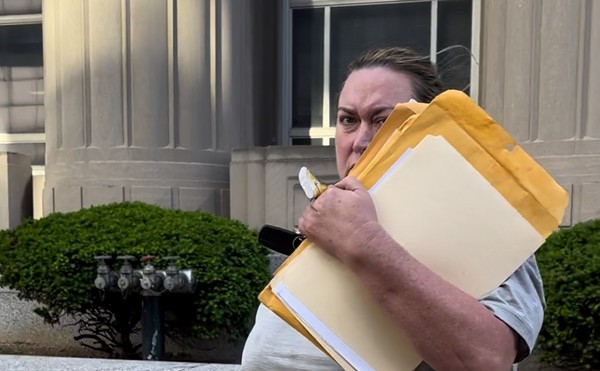Milam environmental engineer Denny Dennison is driving on a road that runs alongside the dump, which borders Fairmont City and Madison. He points out two radio towers that lay crumpled in a field, destroyed by summer storms. He then turns his attention to the Granite City steel mill that looms in the distance. "Sand plants and steel mills," he says. "It's a good location for a landfill, I think."
Not everyone agrees. And now that Milam seeks to expand northward into Madison, onto a 222-acre lot that includes 18 acres of wetlands, a loose-knit coalition of environmentalists, archaeologists and Native Americans are speaking out.
"Putting a landfill over an aquifer in a wetland in a floodplain is just not a good idea," says Kathleen Logan Smith, executive director of the Missouri Coalition for the Environment. "It brings in a lot of revenue to the town, but property values are going to go down, and people will get cancer."
Dennison counters that landfills are one of the most highly regulated industries in the nation. "They're well run these days," he maintains. "It's not like the old days, when the dumps were always catching fire." He adds that he has never read anything suggesting that landfills adversely affect the health of nearby populations. "We're not a bad neighbor," he says. "You'd be surprised."
The Milam Landfill, which is the size of two football fields, began accepting trash in the late 1950s. It was a shoddy, badly run operation until Waste Management took over in 1984. Today Milam is one of 283 landfills operated by Waste Management, the biggest recycler in North America. Each day an average of 400 truckloads — or 3,000 tons — of trash are deposited at Milam.
The landfill is two miles from the Cahokia Mounds, the largest prehistoric Indian settlement north of Mexico. Six years ago the garbage pile at Milam reached 100 feet in height, and those who scaled Monks Mound could, for the first time, see Milam's trash heap in the distance. There were even times when tourists wondered whether Milam was one of the ancient mounds.
"The landfill degrades the mounds," says Kathy Andria, president of an environmental group named the American Bottom Conservancy.
Bill Iseminger, the assistant site manager at Cahokia Mounds, worries that the landfill will foul even more land. "They have to put the trash somewhere," he says. "But from what we hear, there is a general feeling that people are concerned about having landfills in their area."
Today Milam stands at 170 feet, just five stories shy of the Golden Gate Bridge. The dump is almost at full capacity and must close when it tops out at 180 feet, which is likely to occur sometime in the next five to ten years.
Waste Management officials filed a public notice on June 30, 2005, stating their request to take land from the nearby wetlands and use it as a soil cover for Milam. This plan caught Andria's attention. "I immediately thought it sounded like they were making an excuse to build another landfill in wetlands," she recalls. "They said something about how the site might be used for future activities. And they were calling it North Milam."
Environmentalists say expanding a landfill that sits in a floodplain is simply not good public policy, especially when it means destroying wetlands, which provide natural flood control and help filter pollutants. And because the Illinois Environmental Protection Act regulates landfill expansions in floodplains, some people believe that the Milam expansion might even be illegal.
Jim Bensman, conservation chairman of the Alton-based Piasa Palisades Group of the Sierra Club, asks, "Why in the world would we want a dump in a floodplain? We also don't feel wetlands should be destroyed to build a dump. They're too valuable."
Waste Management has proposed a plan to provide 36 acres of wetlands for the 18 acres that will be destroyed. This plan, however, has done little to quiet the opposition, who say there's no comparison between man-made wetlands and natural ones.
"It's like taking a Ming vase, breaking it into a million pieces, and then promising, 'I'll just pick up another one at Wal-Mart,'" says the Missouri Coalition for the Environment's Smith.
While other municipalities have mounted intense campaigns against landfills, there have been few signs of resistance from the 4,500 residents of Madison. City Attorney John Pappa admits that no one is particularly thrilled about the landfill, but says, "The prospect of increasing city revenues is a positive thing."
If the expansion goes through, Madison will receive up to $1 million per year from Waste Management, increasing city coffers by nearly 25 percent. City officials declined to comment until after a public hearing scheduled for December 21 and 22, when Waste Management officials will formally unveil their plans for North Milam.
Opponents, meanwhile, insist that any economic windfall Madison may reap is not worth building a landfill in their community. Some have gone so far as to call the money Waste Management is offering a "legal bribe."
Joe Durako, the district manager at Milam, says Waste Management goes beyond what the environmental law requires. Liners are required at all landfills, but, says Durako, the North Milam dump will use an enhanced liner with two extra layers — better than what regulations demand.
Andria does not find this fact comforting. "I'm appreciative of that, but I wish [Durako] would take his thick landfill liner and go somewhere else. Somewhere that's not in a floodplain." She concedes that Madison may be seduced by Waste Management's monetary offerings, but adds, "I think it's a sad commentary on the status of a community when they have to live by a garbage dump."





